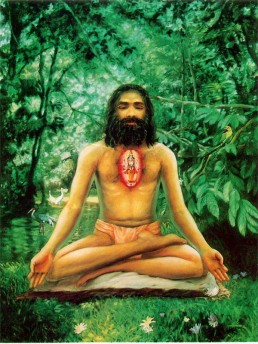Swami Chinmayananda
Swami Chinmayananda Commentary
All religions in the world are great, but indeed, none of them is so perfect as the religion of Vedanta, if by religion we mean the “Science of Self-perfection”. In this stanza, the author of the Geeta says, in unequivocal terms, that the perfect man of Self-knowledge or God-realisation is not merely one who has realised his own divinity, but is also one who has equally understood and has come to live in an intimate knowledge and experience of the divinity inherent in all creatures, without any distinction whatsoever. The Awareness in us is the Awareness everywhere in all names and forms and this Divine Awareness is the very essence in the entire world of perceptions and experience. To contact the Infinite in us, is to contact the Eternal everywhere.
To a true man of realisation, in Hinduism, there is no more a world to be addressed, even be it in divine compassion, by the disgusting phrase: “O! Ye Children of Sin!” Rama Tirtha, a Hindu Saint of Perfection, could not but address the entire living kingdom as “O! Children of Light!” This idea of the consummate revelation of “God-I am” gained by the meditator is the Peak of Perfection endorsed and aimed at by the Hindu Seers. This idea has been most effectively brought out in this stanza.
That this pluralistic phenomenon is a manifestation of and a projection upon the Immortal Truth is very well brought out in almost all the Geeta chapters. The essence in all names and forms, thus, is the same transcendental Self. Just as the mud in all mud-pots, the gold in all gold ornaments, the ocean in all waves, the electricity in all bulbs, the Self is the Essence in and the Substratum for the entire world of objects.
From the physical body we perceive the physical world, and from our emotional level we perceive the emotions in others. So too, from our intellectual level alone, can we intelligently contact the ideas in other intellects. As asserted in the previous chapter, when an individual transcends his intellect, he rediscovers his own Divine Nature, and from that Spiritual Centre, when he looks out, he finds the Self pervading everywhere. The meditator, on transcending his intellect, becomes the Self; and to the Self there is nothing but the Self everywhere. To the mud, there are no pots; to the gold, there are no ornaments separate from itself.
With this understanding in our mind, the stanza becomes quite clear when it says: “HE BEHOLDS THE SELF IN ALL BEINGS AND EQUALLY BEHOLDS ALL BEINGS IN THE SELF.” Such a Perfect One, who has realised the Unity in the world of diversity, alone can afford to entertain the equality of vision in all circumstances and conditions — “on a noble Brahmana, a cow, an elephant, a dog and a Pariah” (V-18).
NOW WILL BE DESCRIBED THE EFFECT OF THIS PERCEPTION OF UNITY OF THE SELF:
Adi Sankara Commentary
Yoga-yukta-atma, one who has his mind Self-absorbed through Yoga, whose mind is merged in samadhi; and sarvatra-sama-darsanah, who has the vision of sameness everywhere-who has the vision (darsana) of sameness (sama-tva), the knowledge of identity of the Self and Brahman everywhere (sarvatra) without exception, in all divergent objects beginning from Brahma to immovable things; iksate, sees; atmanam, the Self, his own Self; sarva-bhuta-stham, existing in everything; and sarva-bhutani, everything from Brahma to a clump of grass; unified atmani, in his Self. The fruit of this realization of the unity of the Self is being stated:
The Bhagavad Gita with the commentary of Sri Sankaracharya – Translated by Alladi Mahadeva Sastry
Holy Geeta – Commentary by Swami Chinmayananda
The Bhagavad Gita by Eknath Easwaran – Best selling translation of the Bhagavad Gita
The Bhagavad Gita – Translation and Commentary by Swami Sivananda
Bhagavad Gita – Translation and Commentary by Bhaktivedanta Swami Prabupadha
Srimad Bhagavad Gita Chapter 6 – Verse 29 – 6.29 sarvabhutasthamatmanam – All Bhagavad Gita (Geeta) Verses in Sanskrit, English, Transliteration, Word Meaning, Translation, Audio, Shankara Bhashya, Adi Sankaracharya Commentary and Links to Videos by Swami Chinmayananda and others – 6-29

